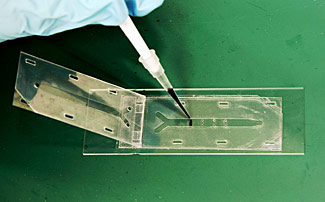New NIST 'cell assay on a chip': solid results from simple means
10 Feb 2012
The great artist and inventor Leonardo da Vinci once said that ''simplicity is the ultimate sophistication.'' National Institute of Standards and Technology (NIST) research engineer Javier Atencia certainly believes in the wisdom of what da Vinci preached; he has a reputation for creating novel microfluidic devices out of ordinary, inexpensive components.
This time, he has combined a glass slide, plastic sheets and double-sided tape into a ''diffusion-based gradient generator'' - a tool to rapidly assess how changing concentrations of specific chemicals affect living cells.
Atencia's latest innovation offers a simple and inexpensive way to expose an array of cultured cells to a chemical gradient - a solution where the chemical concentration changes gradually and predictably across the array. Such gradients are a rapid, high-throughput way to evaluate the effect on cell growth or toxicity.
There are two distinct advantages to the new NIST system over traditional microfluidic cell assay devices. The first is that the gradient is created by diffusion - the gentle movement of matter from one point to another by random molecular motion. Conventional microfluidic systems usually mix fluids by pumping them in a circular motion or by twisting and folding them together. Diffusion greatly reduces the risk of cells being swept away or damaged by shearing forces in the test fluid.
 |
| NIST researchers have combined a glass slide, plastic sheets and double-sided tape to create an inexpensive and simple-to-build microfluidic device for exposing an array of cells to different concentrations of a chemical. Credit: Cooksey / NIST |
The second big advantage is simplicity. The gradient generator is built in layers, with each section precisely positioned with an alignment tab. The base is a glass slide, upon which is attached a strip of double-sided tape cut to have a row of four micrometer-sized channels. Atop this goes a polystyrene strip cut to have two lines each of four tiny circular ''wells'' where each pair lines up with the ends of the channel below it. The next layer is another strip of double-sided tape, this time with a Y-shaped canal cut into it to serve as the flow path for the chemical gradient. Finally, a Mylar strip cut to have an identical Y-canal serves as the cover.
chipscale cell assay
The hinged cover allows access to the wells for adding test cells. Once done, the cover is lowered and affixed, sealing the gradient generator. Fluid flow in and out of the system is accomplished using another Atencia innovation, magnetic connectors. Kept at constant pressure, this flow assures a steady-state stream through the device and creates a diffusion gradient in each buried channel. Cells in the channels are simultaneously exposed to a range of chemical concentrations from high to low.






























